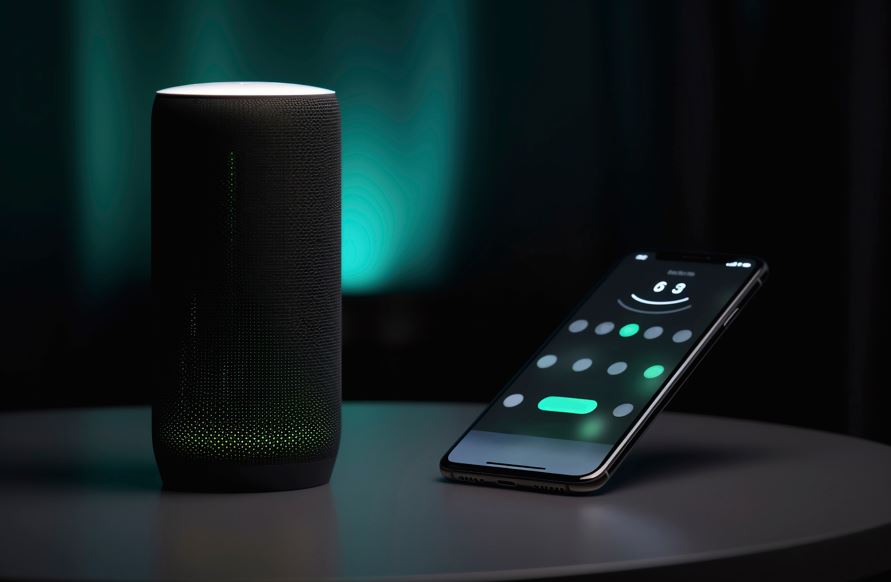Voice Recognition and AI Transforming - the Way We Use Smartphones
12th October 2024
Jake Hopkins
Voice recognition technology has brought about a significant revolution in the mode of interaction with smartphones, thereby enhancing the efficiency and ease of completing tasks. The advantages of this technology are extensive, ranging from hands-free operation to personalized voice commands.
This discussion will delve into the various applications of voice recognition technology, the contribution of artificial intelligence in its advancement, and the existing limitations that necessitate resolution. Discover the transformative impact of voice recognition technology on smartphone usability and its augmentation of daily activities.
What Is Voice Recognition Technology?
Voice Recognition Technology is defined as the capability of a machine or software to receive and comprehend spoken language or commands. It is a segment of Artificial Intelligence that concentrates on revolutionizing user interactions with technology through facilitating speech recognition and response.
This technology has undergone significant advancements over time, exhibiting enhanced accuracy and efficiency in deciphering human speech patterns. Voice Recognition Technology has been widely applied across various sectors, including virtual assistants like Siri, Google Assistant, and Alexa, automotive systems for hands-free operation, and customer service platforms for automated interactions.
By incorporating Artificial Intelligence, these systems continuously learn and adjust to enhance user experiences, fostering seamless communication between individuals and machines. The ongoing progress in voice recognition has paved the way for user-centric interfaces that cater to a diverse array of requirements and preferences.
What Are the Advantages of Voice Recognition Technology?
Voice Recognition Technology provides a multitude of benefits, such as driving innovation in the realm of digital assistants and smart devices. This technology improves user engagement through the facilitation of hands-free operation and personalized automation.
Moreover, Voice Recognition Technology streamlines tasks and enhances productivity by allowing users to execute a diverse range of functions solely through voice commands. Through the incorporation of digital assistants like virtual assistants or chatbots, users can efficiently manage appointments, establish reminders, send messages, and even govern smart home devices with ease. The user-friendly nature and seamless integration of voice recognition technology contribute to elevated user experiences and increased convenience in daily activities.
1. Hands-Free Operation
The Hands-Free Operation feature in Voice Recognition Technology enables users to interact with devices through voice commands, facilitating convenience and seamless user engagement.
This functionality not only enhances user convenience but also plays a critical role in improving technology accessibility for individuals with physical disabilities. By removing the necessity for manual input, hands-free operation streamlines tasks and supports efficient device interaction. Whether users are setting reminders, placing calls, or managing smart home devices, the capability to navigate technology via voice commands opens up a plethora of opportunities. In today's era of multitasking and fast-paced lifestyles, hands-free operation enables users to maintain productivity while on the go, thereby enhancing the overall user experience.
2. Increased Accessibility
Voice Recognition Technology improves accessibility on mobile devices by adjusting to user preferences and delivering an enhanced user experience.
This technology enables users to operate their devices hands-free, simplifying tasks and enhancing convenience. Through verbal commands, users can easily send messages, place calls, schedule reminders, or conduct web searches effortlessly. The versatility of voice recognition technology guarantees that individuals with disabilities or those who favor a hands-free method can fully exploit their mobile devices without hindrances. This advancement not only enhances accessibility for all users but also elevates the general user experience by providing a more intuitive and user-friendly interface.
3. Improved Efficiency
Voice Recognition Technology enhances task efficiency through automation, thereby increasing productivity with its advanced features. This technology transforms the user-device interaction by facilitating the seamless integration of voice commands, thereby enhancing user experiences. By articulating commands verbally, tasks can be swiftly and accurately executed, eliminating the necessity for manual inputs.
Users can effortlessly dictate emails, schedule appointments, control smart home devices, and carry out various other functions.
This heightened convenience not only saves time but also reduces the likelihood of errors, culminating in a more streamlined workflow. The capability to multitask effectively is enhanced as individuals can issue commands verbally while concentrating on other tasks, thereby ensuring smoother and more efficient operations.
What Are the Applications of Voice Recognition Technology?
Voice recognition technology is widely utilized in various applications such as virtual assistants and speech recognition, leading to a transformation in user interactions with technology. The capabilities of this technology are continuously evolving, allowing users to perform tasks like setting reminders through virtual assistants, converting spoken words into text with high precision, and controlling smart devices using voice commands.
The integration of voice recognition technology into daily routines is increasingly common, with individuals now able to dictate messages without the need for manual input or adjust settings on smart devices through simple verbal instructions. These advancements offer enhanced convenience and accessibility, reshaping the ways in which individuals engage with their devices and navigate the digital landscape.
1. Virtual Assistants
Virtual Assistants powered by Voice Recognition Technology provide users with an enhanced and personalized experience through seamless integration with mobile technology. By leveraging advanced voice recognition algorithms, these virtual assistants can accurately interpret and respond to user commands, enhancing the intuitiveness and efficiency of interactions.
The fusion of virtual assistants with mobile devices has transformed the methods through which individuals access information, manage tasks, and communicate.
Virtual assistants offer a convenient and hands-free approach to navigating the digital realm, enabling users to perform a myriad of activities such as setting reminders, sending messages, conducting web searches, and controlling smart home devices. This technology has significantly enhanced the accessibility of various services, establishing itself as an essential tool in our daily routines.
2. Voice-Activated Devices
Voice-Activated Devices leverage Voice Recognition Technology to provide seamless voice control, adapting to user preferences on smart devices to enhance functionality.
The applications of these cutting-edge devices are extensive and varied. Voice-Activated Devices can be applied in smart homes to govern a range of functions, including lighting, thermostats, and security systems through simple voice commands. They are increasingly integrated into vehicles to facilitate hands-free navigation, phone calls, and entertainment management. These devices not only offer convenience but also accessibility for individuals with mobility impairments, simplifying tasks and improving efficiency. Their capacity to recognize diverse voices and accents further refines their usability across various environments.
3. Speech-to-Text Transcription
The utilization of Voice Recognition Technology to power Speech-to-Text Transcription facilitates efficient data analysis, text input, and the provision of cloud-based computing services.
The process of converting spoken words into written text, as enabled by Speech-to-Text Transcription, plays a pivotal role in enhancing accessibility and productivity. This innovative technology not only elevates the accuracy of transcribed content but also expedites the transformation of verbal information into actionable data.
The incorporation of cloud computing serves to further enhance the capabilities of Voice Recognition Technology by establishing a scalable and secure environment for the processing of extensive volumes of voice data. Through this seamless integration of transcription and cloud services, users are afforded a convenient and dependable means of interacting with digital devices through spoken commands and inputs.
How Is AI Used in Voice Recognition Technology?
Artificial Intelligence (AI) assumes a pivotal role in Voice Recognition Technology through its facilitation of Natural Language Processing and intelligent systems that heighten the precision and efficacy of voice-based interactions.
By incorporating sophisticated algorithms, AI enables voice recognition systems to perpetually learn and develop, adjusting to diverse accents, languages, and speech patterns to foster more personalized user experiences. This technology enables devices not only to identify words but also to grasp the context, intentions, and emotions conveyed through spoken language.
Through intricate machine learning models, AI-driven voice recognition technology can anticipate user demands, execute tasks proficiently, and deliver seamless interactions across a spectrum of applications, such as virtual assistants, customer service platforms, and smart home devices.
1. Natural Language Processing (NLP)
The integration of Natural Language Processing (NLP) within Voice Recognition Technology facilitates the identification of language patterns, employing neural language models to conduct sophisticated data analysis.
This technology enables devices to comprehend and decipher human language, enabling them to accurately process and respond to verbal commands. Through the examination of extensive linguistic data, NLP algorithms can iteratively enhance their language recognition capabilities.
Neural language models, including recurrent neural networks and transformers, assume a pivotal role in augmenting the precision and contextual comprehension of voice recognition systems. The utilization of data analysis methodologies, such as natural language understanding and machine learning, further optimizes these systems to deliver enhanced performance and user experience.
2. Machine Learning
The incorporation of Machine Learning algorithms in Voice Recognition Technology serves to enhance adaptability and facilitate the development of advanced features, with a primary focus on optimizing user interactions through intelligent design.
These algorithms enable voice recognition systems to undergo continual learning and adjustment to accommodate users' speech patterns and accents, thereby leading to interactions that are more precise and tailored to the individual. By incorporating sophisticated features like natural language processing and emotion recognition, these systems are capable of interpreting not only words but also the context and emotions accompanying them. This level of technological sophistication not only heightens the accuracy of voice recognition but also enriches the overall user experience.
The field of interaction design assumes a pivotal role in ensuring that voice-based systems are intuitive and user-friendly, thereby simplifying the process of individuals interacting with technology through natural language commands.
3. Voice Biometrics
Voice Biometrics in Voice Recognition Technology provides advanced security measures through voiceprint identification, ensuring secure user authentication and data privacy. This technology operates by scrutinizing unique features in an individual’s voice, such as pitch, frequency, and cadence, to establish a voiceprint that serves as a digital representation of their voice.
Voice biometrics can effectively authenticate a person's identity, rendering it a dependable approach for user verification. Besides enhancing security, voice biometrics eradicates the necessity for conventional password-based authentication methods that are susceptible to hacking or phishing attacks.
Data privacy assumes paramount importance in voice-based systems, as voiceprints must be securely stored and encrypted to deter unauthorized access or misuse of personal data.
What Are the Limitations of Voice Recognition Technology?
Voice Recognition Technology, despite its advancements, encounters limitations such as difficulties with accents and dialects, along with privacy issues concerning data security.
Accents and dialects present notable obstacles for voice recognition systems, leading to inaccuracies in converting speech to text. Various accents and regional speech variations can perplex the software, leading to imprecise transcriptions. Furthermore, interference from background noise can impede the precision of voice commands, impacting the overall functionality of the technology.
Along with these technical obstacles, privacy implications emerge as speech data gets gathered and retained, prompting apprehensions about unauthorized access and potential misappropriation of sensitive information.
1. Accents and Dialects
The challenge posed by accents and dialects for Voice Recognition Technology necessitates the implementation of advanced language recognition and multimodal interaction techniques to achieve accurate speech processing.
Variations in accents and dialects can have a substantial impact on the precision of voice recognition systems, leading to misunderstandings and errors in the interpretation of spoken commands. Consequently, there is an increasing demand for the incorporation of a wide range of speech patterns and linguistic subtleties into the algorithms utilized by these technologies.
By augmenting language recognition capabilities and facilitating multimodal interactions, Voice Recognition Technology can enhance its ability to comprehend diverse regional accents, colloquial expressions, and linguistic variations. This advancement is essential for ensuring seamless and efficient communication between users and voice-operated devices in a multitude of linguistic contexts.
2. Background Noise
The interference of background noise can have a detrimental impact on Voice Recognition Technology, thereby necessitating the implementation of speech enhancement techniques, integration of ambient intelligence, and utilization of acoustic modeling to optimize its performance.
This challenge is particularly pronounced in environments characterized by high levels of noise, such as bustling offices or crowded public spaces. Speech enhancement solutions play a pivotal role in isolating the user's voice from the surrounding background noise, which is essential for ensuring precise recognition.
By integrating ambient intelligence features, Voice Recognition Technology can effectively adjust to diverse environments and dynamically modify settings to enhance accuracy. Acoustic modeling techniques aid in the differentiation between various noise sources and filtering out extraneous sounds, thereby augmenting the system's capacity to accurately interpret and respond to user commands.
3. Privacy Concerns
Privacy concerns related to Voice Recognition Technology are centered on data security and the safeguarding of personal information, underscoring the significance of secure interactions and protection of user data.
Voice Recognition Technology has prompted inquiries into the storage, access, and utilization of user data. Organizations incorporating this technology must establish robust security measures to prevent unauthorized access to sensitive information. Encryption methods are pivotal in ensuring the protection of data collected through voice commands.
It is imperative to have protocols for personal data protection in place to establish trust with users. Clear and transparent communication regarding the usage and sharing of data is crucial for upholding a secure and user-friendly environment.
How Is Voice Recognition Technology Transforming the Use of Smartphones?
Voice Recognition Technology is transforming smartphone utilization through hands-free operation, personalized voice commands, and heightened efficiency and productivity on mobile devices. This advanced technology enables users to dictate messages, conduct web searches, set reminders, and execute various tasks by simply speaking to their device.
Not only does Voice Recognition Technology simplify daily interactions, but it also enhances accessibility for individuals with physical impairments. The incorporation of voice-activated features like virtual assistants further enhances the user experience, granting immediate access to information and services.
As this technology progresses, we anticipate the emergence of even more innovative applications tailored to the diverse needs and preferences of smartphone users.
1. Hands-Free Operation
The implementation of Hands-Free Operation on smartphones using Voice Recognition Technology provides users with user-friendly experiences by incorporating voice-activated commands to enhance interactions with smart devices.
This advanced technology enables users to carry out a variety of tasks on their smartphones without the need for physical contact with the device. It offers a convenient and effective method to remain connected and organized. By simply utilizing voice commands, individuals can send messages, make calls, set reminders, and even manage smart home devices effortlessly.
The seamless integration of voice-activated features not only simplifies navigation and multitasking but also enhances accessibility for users with limited mobility or visual impairments. This makes mobile usage more inclusive and accessible to a diverse range of individuals.
2. Personalized Voice Commands
Smartphones utilize personalized voice commands to provide adaptability and customization options, enhancing user experiences through a voice interface. This technology facilitates users in interacting with their devices in a more natural and efficient manner, allowing them to set reminders, send messages, make calls, and even control smart home devices using only their voice.
The integration of voice interfaces for personalized and tailored interactions has transformed the way individuals engage with technology, simplifying tasks and promoting hands-free operation. The capacity to tailor voice commands according to individual preferences guarantees a smoother and more personalized user experience, thereby propelling us towards a more interconnected and intuitive digital realm.
3. Increased Efficiency and Productivity
Voice Recognition Technology enhances efficiency and productivity on smartphones through task automation and the provision of advanced features to streamline user experiences. This technology enables users to execute various functions on their smartphones simply by speaking, eliminating the necessity for manual input and saving valuable time.
By incorporating voice commands for activities such as sending messages, setting reminders, making calls, and browsing the web, users can effectively multitask and achieve more within shorter durations. Additionally, voice-controlled operations facilitate hands-free usage, presenting users with the convenience to navigate their devices while on the move.
The seamless incorporation of Voice Recognition Technology further augments user productivity and efficiency within the smartphone domain.















